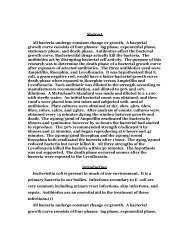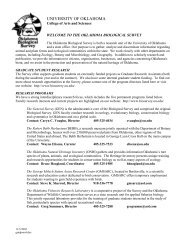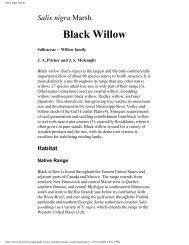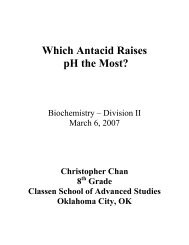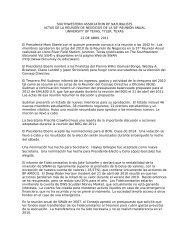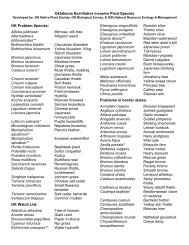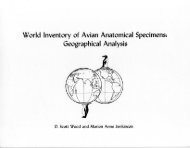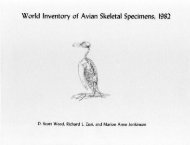Caecidotea mackini, new species, with a synopsis of the ... - BioOne
Caecidotea mackini, new species, with a synopsis of the ... - BioOne
Caecidotea mackini, new species, with a synopsis of the ... - BioOne
You also want an ePaper? Increase the reach of your titles
YUMPU automatically turns print PDFs into web optimized ePapers that Google loves.
PROCEEDINGS OF THE BIOLOGICAL SOCIETY OF WASHINGTON<br />
119(4):563–575. 2006.<br />
<strong>Caecidotea</strong> <strong>mackini</strong>, <strong>new</strong> <strong>species</strong>, <strong>with</strong> a <strong>synopsis</strong> <strong>of</strong> <strong>the</strong> subterranean<br />
asellids <strong>of</strong> Oklahoma (Crustacea: Isopoda: Asellidae)<br />
Julian J. Lewis*, G. O. Graening, Danté B. Fenolio, and Elizabeth A. Bergey<br />
(JJL) Lewis & Associates LLC; Cave, Karst & Groundwater Biological Consulting,<br />
17903 State Road 60, Borden, Indianna 47106-8608, U.S.A., e-mail: lewisbioconsult@aol.com;<br />
(GOG, EAB) Oklahoma Biological Survey and Department <strong>of</strong> Zoology,<br />
University <strong>of</strong> Oklahoma, Norman, Oklahoma 73019, U.S.A.;<br />
(DBF) Department <strong>of</strong> Biology, University <strong>of</strong> Miami, Coral Gables, Florida 33124, U.S.A.<br />
Abstract.—A survey <strong>of</strong> cave and spring fauna in Oklahoma resulted in <strong>the</strong><br />
discovery <strong>of</strong> <strong>Caecidotea</strong> <strong>mackini</strong>, <strong>new</strong> <strong>species</strong>, which is described from<br />
specimens collected in Long’s Cave, Delaware County. Within <strong>the</strong> hobbsi<br />
group <strong>of</strong> <strong>the</strong> genus <strong>Caecidotea</strong>, C. <strong>mackini</strong> belongs to a subset <strong>of</strong> nine <strong>species</strong><br />
termed <strong>the</strong> tridentata assemblage. All nine are subterranean, but several<br />
retain vestigial eyes or pigmentation. Correlated <strong>with</strong> zoogeographic and<br />
climatic evidence, <strong>the</strong> invasion <strong>of</strong> groundwaters by an epigean progenitor<br />
during <strong>the</strong> middle to late Tertiary is suggested. Besides C. <strong>mackini</strong>, <strong>new</strong><br />
records for C. macropropoda, C. acuticarpa, C. stiladactyla, C. steevesi, C.<br />
ancyla, C. antricola, C. adenta,andC. simulator expand <strong>the</strong> known ranges <strong>of</strong><br />
<strong>the</strong>se cryptic <strong>species</strong>. With <strong>the</strong> recognition <strong>of</strong> two patterns <strong>of</strong> fourth pleopod<br />
morphology in C. acuticarpa, <strong>the</strong> <strong>species</strong> specificity <strong>of</strong> this character has<br />
become questionable. Although previously used to differentiate C. simulator<br />
and C. steevesi, fur<strong>the</strong>r splitting or synonymy based on this pleopod<br />
anatomy is reserved until a better understanding <strong>of</strong> its differentiation is<br />
achieved.<br />
Although Oklahoma is not known for<br />
possessing extensive karst areas, almost<br />
2000 caves have been reported and<br />
numerous subterranean <strong>species</strong> are<br />
known from <strong>the</strong> state as summarized by<br />
Black (1971). In 2004, <strong>the</strong> Oklahoma<br />
Biological Survey continued a major faunal<br />
survey <strong>of</strong> caves and springs that built<br />
on work initiated by The Nature Conservancy<br />
in 2000. This recent sampling<br />
produced <strong>the</strong> material used herein for<br />
<strong>the</strong> description <strong>of</strong> <strong>the</strong> <strong>new</strong> <strong>species</strong> <strong>of</strong><br />
<strong>Caecidotea</strong>, as well as expanding our<br />
knowledge <strong>of</strong> <strong>the</strong> ranges <strong>of</strong> <strong>species</strong><br />
constituting <strong>the</strong> subterranean asellid isopod<br />
fauna <strong>of</strong> Oklahoma.<br />
* Corresponding author.<br />
The Springfield Plateau section <strong>of</strong> <strong>the</strong><br />
Ozark Plateaus physiographic province,<br />
occurring primarily in Missouri and<br />
Arkansas, barely extends into nor<strong>the</strong>astern<br />
Oklahoma. Although perhaps not as<br />
cavernous as o<strong>the</strong>r parts <strong>of</strong> <strong>the</strong> Ozarks,<br />
many caves occur in this part <strong>of</strong> Oklahoma.<br />
A smaller area containing caves is<br />
<strong>the</strong> Arbuckle Mountains Uplift in <strong>the</strong><br />
south-central part <strong>of</strong> <strong>the</strong> state. It is<br />
separated from <strong>the</strong> Springfield Plateau<br />
by <strong>the</strong> Arkoma Basin, a region <strong>of</strong> noncavern<br />
forming strata. O<strong>the</strong>r isolated<br />
caves are found in <strong>the</strong> western half <strong>of</strong><br />
Oklahoma, where <strong>the</strong>y have formed in<br />
Permian gypsum or Paleozoic limestone<br />
(Black 1971).<br />
Black (1971) listed seven <strong>species</strong> <strong>of</strong><br />
Asellus (5<strong>Caecidotea</strong> Packard, 1871) be-
564 PROCEEDINGS OF THE BIOLOGICAL SOCIETY OF WASHINGTON<br />
lieved to be cavernicoles and two springdwelling<br />
<strong>species</strong> <strong>of</strong> Lirceus (Rafinesque,1820).<br />
Of <strong>the</strong> seven <strong>Caecidotea</strong>,<br />
only four were valid <strong>species</strong> or actually<br />
occurred in Oklahoma: C. macropropoda<br />
C. acuticarpa, C. stiladactyla and C.<br />
adenta. Black (1971) included C. tridentata<br />
in his list, a <strong>species</strong> described by<br />
Hungerford (1922) from a cistern in<br />
eastern Kansas. Over <strong>the</strong> years, isopods<br />
collected from a variety <strong>of</strong> habitats across<br />
several states were mis-identified as C.<br />
tridentata, including caves in <strong>the</strong> Arbuckle<br />
Uplift (Harrel 1960, Black 1971,<br />
Fleming 1972a). Lewis & Bowman (1981)<br />
redescribed C. tridentata and restricted its<br />
range to east-central Kansas.<br />
O<strong>the</strong>r <strong>species</strong> included in <strong>the</strong> list <strong>of</strong><br />
Black (1971) were C. ozarkana and C.<br />
oculata. Chase & Blair (1937) described<br />
C. macropropoda and C. ozarkana from<br />
a cave and spring five miles south <strong>of</strong> <strong>the</strong><br />
town <strong>of</strong> Kansas, Adair County, Oklahoma.<br />
Lewis (1982) synonymized C.<br />
ozarkana <strong>with</strong> C. macropropoda. <strong>Caecidotea</strong><br />
oculata remains somewhat <strong>of</strong> an<br />
enigma. Mackin & Hubricht (1940) reported<br />
this <strong>species</strong> only from surface<br />
streams in <strong>the</strong> Ouachita Mountains but<br />
described it as having reduced eyes. Until<br />
more can be learned <strong>of</strong> C. oculata, its<br />
ecological classification remains uncertain,<br />
but it remains unknown from subterranean<br />
waters.<br />
Fleming (1972a) described C. steevesi<br />
from Carrico Cave (Dade County, Missouri),<br />
seeps at <strong>the</strong> town <strong>of</strong> Baxter<br />
Springs (Cherokee County, Kansas), and<br />
Gittin’ Down Mountain Cave (Adair<br />
County, Oklahoma). Lewis (1999) examined<br />
<strong>the</strong>se collections and discovered<br />
that <strong>the</strong> fourth pleopod exopod morphology<br />
<strong>of</strong> <strong>the</strong> Baxter Springs isopods<br />
was distinct from that <strong>of</strong> C. steevesi and<br />
described <strong>the</strong>m as C. simulator. Fleming<br />
(1972a) also described C. ancyla from<br />
Brewer Cave, Boone County, Arkansas,<br />
and Three Forks Cave, Adair County,<br />
Oklahoma.<br />
Thus, five obligate subterranean isopod<br />
<strong>species</strong> were previously known from<br />
Oklahoma. Herein is presented <strong>the</strong> description<br />
<strong>of</strong> a <strong>new</strong> <strong>species</strong> <strong>of</strong> <strong>Caecidotea</strong>,<br />
<strong>the</strong> first records <strong>of</strong> C. antricola and C.<br />
simulator from Oklahoma, and records <strong>of</strong><br />
o<strong>the</strong>r collections examined that contribute<br />
to knowledge <strong>of</strong> <strong>the</strong> habitat and range<br />
<strong>of</strong> <strong>the</strong> subterranean asellid fauna <strong>of</strong><br />
Oklahoma and adjacent states.<br />
Names <strong>of</strong> collectors are abbreviated in<br />
<strong>the</strong> text: G. Graening (GG), D. Fenolio<br />
(DF), M. Slay (MS), J. Stout (JS). The<br />
taxonomy and identifications are that <strong>of</strong><br />
<strong>the</strong> senior author, while <strong>the</strong> remainder <strong>of</strong><br />
<strong>the</strong> paper was a collaborative effort <strong>of</strong><br />
all <strong>the</strong> authors. The material examined<br />
for this project is deposited in <strong>the</strong><br />
collection <strong>of</strong> <strong>the</strong> National Museum <strong>of</strong><br />
Natural History, Smithsonian Institution<br />
(USNM). In <strong>the</strong> interest <strong>of</strong> cave conservation,<br />
specific locations are not given but<br />
can be obtained from <strong>the</strong> Oklahoma<br />
Biological Survey.<br />
Systematics<br />
Family Asellidae<br />
Genus <strong>Caecidotea</strong> Packard, 1871<br />
<strong>Caecidotea</strong> <strong>mackini</strong> Lewis, <strong>new</strong> <strong>species</strong><br />
Figs. 1, 2a–f, 3a–e, 4a, b<br />
Material examined.—OKLAHOMA:<br />
Delaware Co., Long’s Cave, ca. 7.5 mi<br />
(12 km) south <strong>of</strong> Jay, 31 Aug 2001, GG,<br />
MS, DF, S. McGinnis, 10.4 mm male<br />
paratype, (USNM 1087373); same locality,<br />
26 Jul 2005, GG, MS, 11.5 mm male<br />
holotype (USNM 1087371), 9.5 mm male<br />
paratype, 6 female paratypes (USNM<br />
1087372).<br />
Description.—Eyeless, unpigmented.<br />
Longest male 11.5 mm, female 12.5 mm,<br />
body slender, linear, approximately 5.83<br />
as long as wide, coxae visible in dorsal<br />
view. Margins <strong>of</strong> head, pereonites and<br />
pleotelson lined <strong>with</strong> setae and spines.<br />
Head approximately 1.63 as wide as<br />
long, anterior margin concave, rostrum<br />
absent; post-mandibular lobes moderately
VOLUME 119, NUMBER 4 565<br />
Fig. 1. <strong>Caecidotea</strong> <strong>mackini</strong>, Long’s Cave, Delaware Co., Oklahoma: a–e, male: (a) habitus, (b), head,<br />
antenna 1, proximal articles antenna 2, (c) left mandible, incisor and lacinia mobilis, (d) right mandible<br />
incisor and palp, (e) maxilla 1, apices <strong>of</strong> inner and outer lobes; f, g, variation in proportions <strong>of</strong> pleotelson<br />
and uropods: (f) 8.3 mm female, (g) 11.4 mm female.<br />
produced. Pleotelson approximately 1.43<br />
as long as wide, sides subparallel, caudomedial<br />
lobe slightly produced, broadly<br />
rounded.<br />
Antenna 1 reaching middle <strong>of</strong> last<br />
article <strong>of</strong> antenna 2 peduncle, flagellum<br />
<strong>of</strong> male approximately 14–16 articles, 7<br />
or 8 distal articles each <strong>with</strong> an es<strong>the</strong>te,<br />
flagellum <strong>of</strong> female <strong>with</strong> approximately<br />
12 articles, 6 distal articles <strong>with</strong> 1 es<strong>the</strong>te<br />
each. Antenna 2 <strong>of</strong> male last article <strong>of</strong><br />
peduncle approximately 1.43 length <strong>of</strong>
566 PROCEEDINGS OF THE BIOLOGICAL SOCIETY OF WASHINGTON<br />
Fig. 2. <strong>Caecidotea</strong> <strong>mackini</strong>, Long’s Cave, Delaware Co., Oklahoma: a, b, male: (a) pereopod 1, (b)<br />
pereopod 4; c–h, variation in pereopod 1 palmar margin <strong>of</strong> propodus: (c) 12.5 mm female, (d) 10.4 mm<br />
male, (e) 9.5 mm male, (f) 11.5 mm male, (g) 11.7 mm female. <strong>Caecidotea</strong> acuticarpa, Byrds Mill Cave,<br />
Pontotoc Co., Oklahoma: (h) pereopod 1, showing diagnostic carpus in relationship to propodus<br />
(setation omitted).<br />
preceding article, flagellum <strong>with</strong> approximately<br />
100–105 articles.<br />
Mandibles <strong>with</strong> 4-cuspate incisors and<br />
lacinia mobilis, adjacent rows <strong>of</strong> 12–14<br />
plumose setae, palp <strong>with</strong> plumose setae<br />
on articles 2 and 3. Maxilla 1, outer lobe<br />
<strong>with</strong> 13 robust spines, inner lobe <strong>with</strong> 5<br />
apical plumose setae. Maxilliped <strong>with</strong> 5 or<br />
6 retinacula.<br />
Pereopod 1 <strong>of</strong> male, propodus approximately<br />
1.93 as long as wide, palmar<br />
margin <strong>with</strong> large proximal spine, subequal<br />
triangular median process, distal<br />
process absent; dactyl flexor margin <strong>with</strong>
VOLUME 119, NUMBER 4 567<br />
Fig. 3. <strong>Caecidotea</strong> <strong>mackini</strong>, Long’s Cave, Delaware Co., Oklahoma: a–e, 12.4 mm male: (a) pleopod 1,<br />
(b) pleopod 2, (c) pleopod 3 exopod, (d) pleopod 4 exopod, (e) pleopod 5 exopod. <strong>Caecidotea</strong> acuticarpa,<br />
Byrds Mill Cave, Pontotoc Co., Oklahoma: (f) pleopod 4 exopod. <strong>Caecidotea</strong> adenta, deep limestone sink<br />
cave, Kiowa Co., Oklahoma: (g) pleopod 4 exopod.<br />
spines; distal margin <strong>of</strong> carpus blunt,<br />
lower than base <strong>of</strong> proximal spine on<br />
palmar margin <strong>of</strong> propodus, <strong>with</strong> 2<br />
robust spines. Pereopod 1 <strong>of</strong> female,<br />
palmar margin propodus <strong>of</strong> largest specimen<br />
<strong>with</strong> large proximal spine, subequal<br />
triangular median process, lower triangular<br />
distal process; o<strong>the</strong>r females <strong>with</strong>out<br />
distal process. Pereopod 4 sexual dimorphism<br />
minimal or absent, basis <strong>with</strong> row
568 PROCEEDINGS OF THE BIOLOGICAL SOCIETY OF WASHINGTON<br />
Fig. 4. The male pleopod 2 endopodite tips <strong>of</strong><br />
selected Oklahoma asellids. <strong>Caecidotea</strong> <strong>mackini</strong>,<br />
Long’s Cave, Delaware Co., Oklahoma: (a) posterior,<br />
(b) anterior. <strong>Caecidotea</strong> acuticarpa, Byrds Mill<br />
Cave, Pontotoc Co., Oklahoma: (c) posterior, (d)<br />
anterior. <strong>Caecidotea</strong> adenta, deep limestone sink<br />
cave, Kiowa Co., Oklahoma: (e) posterior, (f )<br />
anterior. <strong>Caecidotea</strong> ancyla, Dressler Cave, Cherokee<br />
Co., Oklahoma: (g) anterior. Lirceus garmani,<br />
Locust Grove Spring, Delaware Co., Oklahoma:<br />
(h) anterior.<br />
<strong>of</strong> 9 distally plumose setae along margin,<br />
carpus approximately 33 as long as wide,<br />
propodus <strong>with</strong> row <strong>of</strong> 6 distally plumose<br />
setae along margin.<br />
Male pleopod 1 longer than pleopod 2,<br />
protopod approximately 0.63 length <strong>of</strong><br />
exopod, <strong>with</strong> approximately 5 retinacula.<br />
Exopods approximately 0.53 as wide as<br />
long, lateral margin slightly concave, <strong>with</strong><br />
elongate plumose seta on distal margin.<br />
Female pleopod 2 subtriangular <strong>with</strong><br />
approximately 11 or 12 elongate plumose<br />
setae along distal and lateral margins.<br />
Male pleopod 2, distal segment <strong>of</strong> exopod<br />
<strong>with</strong> approximately 12 elongate plumose<br />
setae along margin. Endopod <strong>with</strong> distinct<br />
basal apophysis; tip in anterior<br />
aspect <strong>with</strong> cannula subtrapezoidal; mesial<br />
side <strong>of</strong> U-shaped endopodial groove<br />
forming a low knob-like shoulder leading<br />
up to <strong>the</strong> pronounced mesial process,<br />
which is approximately equal in extent to<br />
cannula, curved mesiad; lateral side <strong>of</strong><br />
endopodial groove forming a second<br />
knob-like shoulder leading up to <strong>the</strong><br />
caudal process, slightly higher than o<strong>the</strong>r<br />
processes, distinctly scalloped laterally.<br />
Tip <strong>of</strong> endopod in posterior aspect <strong>with</strong><br />
prominent scalloped caudal process partially<br />
obscuring cannula, tip <strong>of</strong> mesial<br />
process visible. Pleopod 3 exopod, suture<br />
approximately equidistant between proximal<br />
and distal parts, proximolateral setae<br />
present, approximately 5 apical plumose<br />
setae. Pleopod 4 exopod, proximolateral<br />
setae present, false suture trifurcating.<br />
Pleopod 5 exopod <strong>with</strong> proximal sigmoid<br />
false suture and transverse false suture.<br />
Uropods subcylinidrical, to approximately<br />
23 length <strong>of</strong> pleotelson, endopod<br />
approximately 0.753 length <strong>of</strong> protopod,<br />
sexual dimorphism not apparent.<br />
Etymology.—This <strong>species</strong> is named for<br />
J. G. Mackin, in honor <strong>of</strong> his pioneering<br />
work on <strong>the</strong> asellid fauna <strong>of</strong> Oklahoma<br />
(Mackin 1940, Mackin & Hubricht 1938,<br />
1940; Hubricht & Mackin 1949).<br />
Ecology.—Long’s Cave is a proto-dendritic,<br />
phreatic conduit 350 m in length,<br />
<strong>with</strong> some secondary vadose development.<br />
It was dissolved from <strong>the</strong> Reed<br />
Springs member <strong>of</strong> <strong>the</strong> Mississippian<br />
Boone Formation limestone. This karst<br />
complex concentrates and discharges<br />
a subterranean stream <strong>of</strong> approximately<br />
0.1 cubic meter per minute. The recharge
VOLUME 119, NUMBER 4 569<br />
area is 313 hectares (Aley & Aley 1999) to<br />
which, as presently known, C. <strong>mackini</strong> is<br />
endemic. Human entry into <strong>the</strong> system<br />
requires snorkeling gear at low base-flow<br />
conditions. The Nature Conservancy<br />
owns Long’s Cave and manages it <strong>with</strong>in<br />
<strong>the</strong> Eucha Nature Preserve.<br />
<strong>Caecidotea</strong> <strong>mackini</strong> coexists <strong>with</strong> ano<strong>the</strong>r<br />
stygobitic isopod, C. ancyla. O<strong>the</strong>r<br />
notable aquatic fauna found in Long’s<br />
Cave include <strong>the</strong> Ozark cavefish Amblyopsis<br />
rosae (Eigenmann, 1898), Oklahoma<br />
cave crayfish Cambarus tartarus<br />
(Hobbs & Cooper, 1972), and a cave<br />
amphipod Stygobromus sp.<br />
Relationships.—Within <strong>the</strong> hobbsi <strong>species</strong><br />
group <strong>the</strong>re are several taxa, called<br />
here <strong>the</strong> tridentata assemblage, in which<br />
<strong>the</strong> structures <strong>of</strong> <strong>the</strong> taxonomically important<br />
male pleopod 2 endopod tip are<br />
nearly indistinguishable (Fig. 4a–f). Besides<br />
C. <strong>mackini</strong>, <strong>the</strong>se include C. tridentata<br />
(Kansas, Lewis & Bowman, 1981), C.<br />
acuticarpa (Oklahoma, Mackin & Hubricht,<br />
1940), C. adenta (Oklahoma,<br />
Mackin & Hubricht, 1940), C. reddelli<br />
(Texas, Lewis & Bowman, 1996), C.<br />
salemensis (Missouri, Lewis, 1981), C.<br />
spatulata (Illinois, Missouri, Lewis &<br />
Bowman, 1981) and C. teresae (Indiana,<br />
Lewis, 1982). In each <strong>of</strong> <strong>the</strong>se, <strong>the</strong><br />
endopod tip comprises a low, conical<br />
cannula surrounded by a scalloped,<br />
broadly rounded caudal process and<br />
a mesial process that hooks mesiad<br />
apically. To <strong>the</strong>se might be added C.<br />
lesliei (Illinois, Lewis & Bowman, 1981)<br />
that is clearly a closely related derivative,<br />
lacking only <strong>the</strong> mesial process hook (it is<br />
blunter apically). The male first pleopod<br />
is so similar in <strong>the</strong>se and o<strong>the</strong>r members<br />
<strong>of</strong> <strong>the</strong> hobbsi group that it is <strong>of</strong> little help<br />
in separating <strong>the</strong> <strong>species</strong>. These <strong>species</strong><br />
(Fig. 4d, f, g) mostly possess a type A<br />
pleopod 4 exopod suture pattern (2 false<br />
sutures <strong>with</strong> apical incision, per Lewis &<br />
Bowman 1981) that is frequently correlated<br />
<strong>with</strong> <strong>Caecidotea</strong> inhabiting saturated<br />
soil interstitial habitats ra<strong>the</strong>r than<br />
caves. Only C. salemensis and some<br />
populations <strong>of</strong> C. acuticarpa (see below)<br />
have a type B pleopod 4 and are primarily<br />
cavernicoles. <strong>Caecidotea</strong> <strong>mackini</strong> is separated<br />
from all <strong>species</strong> in <strong>the</strong> assemblage<br />
by <strong>the</strong> sculptured appearance <strong>of</strong> <strong>the</strong> male<br />
pleopod 2 endopod tip (Fig. 4a, b) that<br />
has proximal ledges leading up to <strong>the</strong><br />
mesial and caudal processes. Of <strong>the</strong><br />
<strong>species</strong> <strong>with</strong> adjacent ranges, it is separated<br />
from C. tridentata by <strong>the</strong> absence <strong>of</strong><br />
<strong>the</strong> prominent proximal process on <strong>the</strong><br />
gnathopod (Fig. 2a), from C. acuticarpa<br />
by <strong>the</strong> broader, shorter carpus (Fig. 2h),<br />
and from C. salemensis by <strong>the</strong> type B<br />
pleopod 4 (Fig. 3d) and elongate, cylindrical<br />
uropods (Fig. 1a).<br />
Peck & Lewis (1978) presented a correlation<br />
between <strong>the</strong> distribution <strong>of</strong> subterranean<br />
invertebrates in <strong>the</strong> middle<br />
western United States <strong>with</strong> <strong>the</strong> geological,<br />
climatic and vegetational history <strong>of</strong> <strong>the</strong><br />
region. Although all members <strong>of</strong> <strong>the</strong><br />
tridentata assemblage are subterranean<br />
<strong>species</strong>, C. tridentata, C. acuticarpa, C.<br />
spatulata, C. salemensis, and C. teresae<br />
(and perhaps o<strong>the</strong>rs) retain vestiges <strong>of</strong><br />
pigmentation. <strong>Caecidotea</strong> spatulata has<br />
small eyes and has been collected from<br />
questionably epigean habitats – it is<br />
difficult to know if <strong>the</strong> report <strong>of</strong> this<br />
<strong>species</strong> from temporary surface waters<br />
(Mackin & Hubricht 1940) is a matter <strong>of</strong><br />
preference or accidental discharge from<br />
groundwaters. The retention <strong>of</strong> vestigial<br />
eyes or pigment points to an epigean<br />
ancestor, in this case one that invaded<br />
groundwater habitats over a relatively<br />
wide area (Lewis 1982). The range <strong>of</strong> this<br />
assemblage <strong>of</strong> <strong>species</strong>, from Texas north<br />
into Oklahoma and Kansas <strong>the</strong>n east to<br />
central Indiana (Fig. 5), corresponds to<br />
<strong>the</strong> Great Plains region <strong>of</strong> central North<br />
America. After <strong>the</strong> uplift <strong>of</strong> <strong>the</strong> Rocky<br />
Mountains, during <strong>the</strong> mid-Tertiary cooling<br />
and drying resulted in a shift in<br />
fragmentation <strong>of</strong> <strong>the</strong> forests and <strong>the</strong><br />
creation <strong>of</strong> <strong>the</strong> Great Plains grasslands<br />
(Peck & Lewis 1978). The western part <strong>of</strong>
570 PROCEEDINGS OF THE BIOLOGICAL SOCIETY OF WASHINGTON<br />
Fig. 5. Map <strong>of</strong> <strong>the</strong> south-central United States showing <strong>the</strong> approximate ranges <strong>of</strong> nine <strong>species</strong> <strong>of</strong> <strong>the</strong><br />
<strong>Caecidotea</strong> tridentata <strong>species</strong> assemblage.<br />
this area became <strong>the</strong> most arid and no<br />
subterranean asellids have been discovered<br />
<strong>the</strong>re. Thus, morphologic, zoogeographic<br />
and climatic evidence correlate to<br />
suggest that an epigean ancestor <strong>of</strong> <strong>the</strong><br />
tridentata assemblage invaded groundwaters<br />
as surface habitats became scarcer<br />
during <strong>the</strong> middle to late Tertiary. Today<br />
only a cluster <strong>of</strong> subterranean <strong>species</strong><br />
remain.<br />
<strong>Caecidotea</strong> acuticarpa Mackin &<br />
Hubricht, 1940<br />
Figs. 2h, 3f, 4c, d<br />
Material examined.—OKLAHOMA:<br />
Type A: Johnston Co.: Twin Vulture<br />
Cave, 5 Aug 2005, GG, DF, 2 males, 1<br />
juv; Pontotoc Co.: Byrds Mill Spring,<br />
2 Dec 1930, J. G. Mackin, 4 males,<br />
3 females; 10 Nov 2005, S. Wallace,<br />
1 male, 1 female; Deadman’s Spring,<br />
30 Mar 2006, GG, DF, 2 males, 4<br />
females.<br />
Type B: Johnston Co.: Bruno’s Spring<br />
2, 30 Mar 2006, GG, DF, 6 males, 4<br />
females; Martin Spring, 30 Mar 2006,<br />
GG, DF, male, 2 females; Mystic Cave,<br />
18 Dec 2004, GG, DF, 2 males, 1 female;<br />
spring upstream <strong>of</strong> Tishomingo National<br />
Fish Hatchery, 5 Aug 2005, GG, DF, 1<br />
male, 1 female; spring box upstream <strong>of</strong><br />
Tishomingo National Fish Hatchery, 31<br />
Mar 2006, GG, DF, 4 males, 4 females;<br />
Murray Co.: spring on Hickory Creek,
VOLUME 119, NUMBER 4 571<br />
29 Mar 2006, GG, DF, 5 males, 2<br />
females; Pontotoc Co.: Coal Creek<br />
Cave, 19 Dec 2005, GG, DF, 3 males, 2<br />
females.<br />
Remarks.—Fleming (1972b) synonymized<br />
C. acuticarpa <strong>with</strong> C. tridentata,<br />
but Lewis & Bowman (1981) rejected this<br />
synonymy after examination <strong>of</strong> <strong>the</strong> type<br />
specimens <strong>of</strong> C. acuticarpa and <strong>the</strong> redescription<br />
<strong>of</strong> C. tridentata. Although<br />
described as unpigmented by Mackin &<br />
Hubricht (1940), a diffuse granular magenta<br />
pigment is visible in some specimens,<br />
similar to that seen in o<strong>the</strong>r<br />
tridentata assemblage <strong>species</strong>.<br />
Lewis & Bowman (1981) noticed in<br />
<strong>the</strong>ir analysis <strong>of</strong> <strong>the</strong> subterranean <strong>Caecidotea</strong><br />
in Illinois that <strong>the</strong> fourth pleopod<br />
exopods had two basic patterns. These<br />
were termed: (1) type A (Fig. 3d, f ) <strong>with</strong><br />
a false suture pattern in which <strong>the</strong> distal<br />
part <strong>of</strong> <strong>the</strong> exopod was divided into two<br />
roughly oval parts, and (2) type B<br />
(Fig. 3g) possessing a single sigmoid<br />
suture. These were believed to be <strong>species</strong>specific<br />
and considered useful taxonomic<br />
characters. Examination <strong>of</strong> <strong>the</strong> fourth<br />
pleopod exopods <strong>of</strong> specimens <strong>of</strong> C.<br />
acuticarpa revealed that both type A and<br />
B were present. This presented a dilemma<br />
if this morphology is in fact <strong>species</strong> specific.<br />
Although <strong>the</strong> male pleopod 2 endopod<br />
tip <strong>of</strong> C. acuticarpa is very similar<br />
to that <strong>of</strong> o<strong>the</strong>r tridentata assemblage<br />
<strong>species</strong>, <strong>the</strong> unique shape <strong>of</strong> <strong>the</strong> carpus in<br />
C. acuticarpa is distinctive even under low<br />
magnification (Fig. 2a, h). Until it can be<br />
established whe<strong>the</strong>r pleopod 4 morphology<br />
is <strong>species</strong>-specific, a manifestation <strong>of</strong><br />
polytypic <strong>species</strong>, or perhaps even ecophenotypic,<br />
it is not desirable to split C.<br />
acuticarpa based only on this character.<br />
In <strong>the</strong> material examined, <strong>the</strong> collections<br />
are separated into type A and B populations<br />
for future reference.<br />
Distribution.—<strong>Caecidotea</strong> acuticarpa is<br />
endemic to groundwater habitats in <strong>the</strong><br />
Arbuckle Uplift, where it has been<br />
collected from caves, springs and a well.<br />
It has been reported from Johnston,<br />
Murray, Pontotoc and Seminole counties<br />
(Mackin & Hubricht 1940, Harrel 1963,<br />
Black 1971, Fleming 1972a).<br />
<strong>Caecidotea</strong> adenta Mackin & Hubricht,<br />
1940<br />
Figs. 3g, 4e, f<br />
Material examined.—OKLAHOMA: Kiowa<br />
Co.: deep limestone sink cave 15 mi<br />
south <strong>of</strong> Mountain View, Nov 1936, J. G.<br />
Mackin, 5 males, 5 females.<br />
Remarks.—Specimens <strong>of</strong> an asellid<br />
from a small cave near Turner Falls,<br />
Murray County were collected by J. Holsinger<br />
and R. Norton on 24 June 1964 and<br />
identified by Fleming (1972b) as Asellus<br />
adentus. This is believed to be a misidentification<br />
<strong>of</strong> C. acuticarpa. Murray<br />
County is <strong>with</strong>in <strong>the</strong> known range <strong>of</strong> C.<br />
acuticarpa, whereas C. adenta is known<br />
only from <strong>the</strong> type-locality in <strong>the</strong> Wichita<br />
Mountains. A single female specimen <strong>of</strong><br />
a subterranean <strong>Caecidotea</strong> was collected<br />
by Graening and Fenolio from a well in<br />
Comanche County, Oklahoma, also in <strong>the</strong><br />
Wichita Mountains. The slender gnathopod<br />
<strong>of</strong> this specimen suggests that it is C.<br />
adenta, but collection <strong>of</strong> a male is necessary<br />
to confirm this suspicion.<br />
<strong>Caecidotea</strong> ancyla (Fleming, 1972a)<br />
Fig. 4g<br />
Material examined.—ARKANSAS: Boone<br />
Co.: Brewer Cave, 26 Jun 1964, J. R.<br />
Holsinger, 1 male; Major’s Cave, Jul 1977,<br />
N. Youngsteadt, J. Youngsteadt, 1 male.<br />
Madison Co.: Denny-Horsethief Cave, 4<br />
Jun 1977, M. D. Schram, 22 males, 12<br />
females, Withrow Springs Cave, 6 Aug<br />
1978, M. D. Schram, 5 males, 3 females.<br />
MISSOURI: Camden Co.: Ozark Caverns,<br />
17 Mar 1982, J. E. Gardner, 1<br />
male, 4 females; River Cave, Hahatonka<br />
State Park, 4 Aug 1940, L. Hubricht, 15<br />
females. OKLAHOMA: Adair Co.: Three<br />
Forks Cave, 1 Aug 1970, J. Black, 2 males;<br />
Cherokee Co.: Dressler Cave, 28 Jul 2005,<br />
GG, MS, 2 males, 5 females; Delaware
572 PROCEEDINGS OF THE BIOLOGICAL SOCIETY OF WASHINGTON<br />
Co.: East Hollow Cave, 26 Jul 2005, GG,<br />
MS, 1 male; Engelbrecht Cave, 8 Dec<br />
2004, GG, DF, 1 male; Long’s Cave, 26<br />
Jul 2005, GG, MS; Peach Tree Cave, 27<br />
Jul 2005, GG, MS, 7 males/females;<br />
Spider Cave, 3 May 2005, GG, DF, 3<br />
males, 2 females; Stansbury-January<br />
Cave, J. Lewis, 2 Jun 1981, 4 males, 4<br />
females; 1 Jan 2001, E. Bergey, 1 male, 1<br />
female.<br />
Remarks.—The description <strong>of</strong> <strong>Caecidotea</strong><br />
ancyla by Fleming (1972a) was<br />
sufficient to identify <strong>the</strong> <strong>species</strong>. However,<br />
<strong>the</strong> appearance <strong>of</strong> <strong>the</strong> male second<br />
pleopod endopod tip shown in fig. 4g is<br />
provided as it more typically portrays <strong>the</strong><br />
structure than that shown in Fleming’s<br />
illustration. This <strong>species</strong> co-occurs <strong>with</strong><br />
o<strong>the</strong>r, usually larger <strong>species</strong> (e.g., C.<br />
antricola, C. stiladactyla, C. <strong>mackini</strong>). Its<br />
relatively diminutive size may cause it to<br />
be overlooked or mistaken for juveniles <strong>of</strong><br />
<strong>the</strong> larger <strong>species</strong> <strong>with</strong> which it is syntopic.<br />
Culver & Ehlinger (1980) and Lewis<br />
(1988) documented habitat partitioning<br />
by similar <strong>species</strong> pairs <strong>of</strong> subterranean<br />
<strong>Caecidotea</strong> inhabiting <strong>the</strong> same cave.<br />
Distribution.—<strong>Caecidotea</strong> ancyla is endemic<br />
to <strong>the</strong> Ozarks, where most collections<br />
have been made from <strong>with</strong>in <strong>the</strong><br />
Springfield Plateau, although this <strong>species</strong><br />
is also known from <strong>the</strong> western part <strong>of</strong> <strong>the</strong><br />
Salem Plateau.<br />
<strong>Caecidotea</strong> antricola Creaser, 1931<br />
Material examined.—OKLAHOMA:<br />
Delaware Co.: January-Stansbury Cave,<br />
9 Oct 2001, SH, DF, E. Bergey, 1 male, 1<br />
female; Star Cave, 1 Aug 2005, GG, DF,<br />
2 males, 1 female.<br />
Remarks.—This is <strong>the</strong> most widespread<br />
and common <strong>of</strong> <strong>the</strong> subterranean isopods<br />
<strong>of</strong> <strong>the</strong> Ozarks. Lewis & Bowman (1981)<br />
and Lewis (1988) reported C. antricola<br />
from 14 counties in Missouri and three<br />
counties in Arkansas, spanning both <strong>the</strong><br />
Salem Plateau and Springfield Plateau.<br />
These are <strong>the</strong> first records from Oklahoma.<br />
<strong>Caecidotea</strong> macropropoda Chase &<br />
Blair, 1937<br />
Material examined.—ARKANSAS: Washington<br />
Co.: Spring at Bradley Shelter,<br />
MS, 7 males, 5 females; Snyder Cave,<br />
MS, 4 males, 2 females; Storm Drain<br />
Spring, 28 Nov 2000, MS, 3 males.<br />
OKLAHOMA: Sequoyah Co.: Gum<br />
Spring, 12 Jul 2001, E. Bergey, 3 males.<br />
Remarks.—Dearolf (1953) reported C.<br />
macropropoda from northwestern Arkansas.<br />
Lewis (1982) synonymized C. ozarkana<br />
<strong>with</strong> C. macropropoda and redescribed<br />
<strong>the</strong> <strong>species</strong>. Similar to <strong>the</strong><br />
situation <strong>with</strong> C. stiladactyla, this <strong>species</strong><br />
can be difficult to identify because <strong>of</strong><br />
seeming differences in <strong>the</strong> orientation <strong>of</strong><br />
<strong>the</strong> cannula from specimen to specimen.<br />
The cannula in some specimens appears<br />
to be a decurved tubular structure, while<br />
in o<strong>the</strong>rs it appears more recumbent (per<br />
C. stiladactyla Mackin & Hubricht, 1940).<br />
The positioning and general shape <strong>of</strong> <strong>the</strong><br />
accessory processes <strong>of</strong> <strong>the</strong> male second<br />
pleopod endopod tip are in general <strong>the</strong><br />
same as that figured by Lewis (1982) but<br />
are more pronounced in some specimens.<br />
In one specimen <strong>the</strong> distal process on <strong>the</strong><br />
palmar margin <strong>of</strong> <strong>the</strong> male gnathopod<br />
was bicuspate ra<strong>the</strong>r than rounded. The<br />
suture patterns <strong>of</strong> <strong>the</strong> fourth pleopod<br />
exopod and <strong>the</strong> proximal setation was<br />
similar in all specimens examined, as were<br />
<strong>the</strong> elongate uropods. Due to <strong>the</strong> complexities<br />
<strong>of</strong> <strong>the</strong> morphology <strong>of</strong> asellids (in<br />
particular C. macropropoda, C. stiladactyla,<br />
C. steevesi, and C. simulator) inhabiting<br />
groundwaters <strong>of</strong> <strong>the</strong> Springfield<br />
Plateau, it is necessary to dissect and<br />
slide-mount multiple appendages from<br />
multiple specimens to make accurate<br />
identifications.<br />
Lewis (1999) recorded localities in<br />
Carroll and Washington counties, to<br />
which <strong>the</strong> sites above are added. This<br />
<strong>species</strong> is endemic to <strong>the</strong> Springfield<br />
Plateau in Arkansas and Oklahoma,<br />
where it is found in caves and <strong>the</strong>ir spring<br />
outlets.
VOLUME 119, NUMBER 4 573<br />
<strong>Caecidotea</strong> steevesi (Fleming, 1972a)<br />
Material examined.—ARKANSAS: Madison<br />
Co.: War Eagle Cave, 21 Jun 1981, M. D.<br />
Schram, 2 males; Withrow Springs Cave, 16<br />
Sep 1979, M. D. Schram, 4 males, 7 females;<br />
MISSOURI: Dade Co.: Carrico Cave, 20<br />
Aug 1968, J. R. Holsinger, R. Norton, 5<br />
males, 4 females; OKLAHOMA: Adair Co.:<br />
Gallcatcher Cave, 2 May 2005, GG, DF, 1<br />
male, 2 females; Delaware Co.: Nickel Preserve<br />
Cave #4, 1 Jun 2001, S. Hensley, 1 male.<br />
Remarks.—As noted by Lewis (1999),<br />
<strong>the</strong> primary difference between C. steevesi<br />
and C. simulator is in <strong>the</strong> morphology <strong>of</strong><br />
<strong>the</strong> fourth pleopods. With <strong>the</strong> significance<br />
<strong>of</strong> this pleopod as a taxonomic character<br />
in question (see discussion <strong>of</strong> C. acuticarpa<br />
above), it may be necessary to<br />
synonymize simulator <strong>with</strong> steevesi at<br />
some point. Until such time that a definitive<br />
answer becomes available, no<br />
action is being taken to split or synonymize<br />
<strong>species</strong> based on <strong>the</strong> fourth pleopod<br />
morphology.<br />
Distribution.—<strong>Caecidotea</strong> steevesi is<br />
endemic to <strong>the</strong> Springfield Plateau, where<br />
it occurs in caves in northwestern Arkansas,<br />
southwestern Missouri, and nor<strong>the</strong>astern<br />
Oklahoma (Fleming 1972a, Lewis<br />
1999).<br />
<strong>Caecidotea</strong> simulator Lewis, 1999<br />
Material examined.—OKLAHOMA:<br />
Cherokee Co.: Single Barrel Cave, 28 Jul<br />
2005, GG, MS, 4 males, 3 females;<br />
Delaware Co.: Carroll’s Cenote, 3 May<br />
2004, GG, DF, 1 male, 2 females;<br />
Ottawa Co.: cave near Klugf’s Spring,<br />
28 Jun 2001, J. Waterbury, 6 males/<br />
females; cave on Tripoli land, 14 Dec<br />
2004, GG, DF, MS, 1 male, 1 female;<br />
Schifleff Cave, 6 Dec 2004, GG, DF, 1<br />
male, 1 female.<br />
Remarks.—This <strong>species</strong> was described<br />
by Lewis (1999) from sou<strong>the</strong>astern Kansas<br />
and northwestern Arkansas. With<br />
<strong>the</strong> addition <strong>of</strong> <strong>the</strong> first records from<br />
Oklahoma, <strong>the</strong> range <strong>of</strong> C. simulator<br />
spans <strong>the</strong> western part <strong>of</strong> <strong>the</strong> Springfield<br />
Plateau.<br />
<strong>Caecidotea</strong> stiladactyla Mackin &<br />
Hubricht, 1940<br />
Material examined.—OKLAHOMA:<br />
Adair Co.: Duncan Field Cave, 29 Oct<br />
1996, B. Howard, 1 male; 1 May 2004,<br />
GG, DF, 1 male, 3 females; Delaware<br />
Co.: Anticline Cave, 17 Jan 2006, DF, JS,<br />
4 males; Bolton Cave, 5 mi S Jay, 29 Nov<br />
1970, J. Black, 3 males, 1 female; cave at<br />
Brush Creek bridge, 15 Dec 2004, GG,<br />
MS, DF, 7 males/females; Peach Tree<br />
Cave, 27 Jul 2005, GG, MS, 1 male; Rock<br />
Quarry Cave, 25 Jul 2005, GG, MS, 2<br />
males, 2 females; Spavinaw Bat Cave, 18<br />
Jan 2006, DF, JS, 5 males, 7 females;<br />
spring on Brush Creek, 3 May 2004, GG,<br />
DF, 2 males; Surprise Cave, 27 Jul 2005,<br />
GG, MS, 3 males, 7 females; seep, 6.4 mi<br />
S. Jay, 24 May 1940, L. Hubricht, 8<br />
males, 13 females.<br />
Remarks.—Mackin & Hubricht (1940)<br />
described C. stiladactyla from springs and<br />
seeps in Newton and Boone counties,<br />
Arkansas. Black (1971) listed <strong>the</strong> first<br />
locality in Oklahoma (Delaware County),<br />
to which several more are added here.<br />
This <strong>species</strong> is endemic to <strong>the</strong> Ozark<br />
Springfield Plateau.<br />
Lirceus garmani Mackin & Hubricht,<br />
1949<br />
Fig. 4h<br />
Material examined.—OKLAHOMA:<br />
Delaware Co.: spring at roadside park<br />
1 mi east <strong>of</strong> Locust Grove, 21 Jan 2006,<br />
DF, JS, 4 males, 3 females.<br />
Remarks.—Hubricht & Mackin (1949)<br />
asserted that <strong>the</strong> tip elements <strong>of</strong> <strong>the</strong> male<br />
pleopod 2 endopod were <strong>of</strong> little diagnostic<br />
use. New material collected from<br />
<strong>the</strong> roadside park spring cited by Hubricht<br />
& Mackin (1949) as a locality for<br />
L. garmani was examined. The endopod<br />
tip appeared to be distinctive and a figure<br />
is presented for future comparisons.
574 PROCEEDINGS OF THE BIOLOGICAL SOCIETY OF WASHINGTON<br />
Distribution.—This isopod is an inhabitant<br />
<strong>of</strong> springs, small creeks, ponds<br />
and occasionally cave streams in Arkansas,<br />
Kansas, Oklahoma, and Missouri<br />
(Hubricht & Mackin 1949). In Oklahoma,<br />
Hubricht & Mackin (1949) reported it<br />
from springs in Mayes and Okfuskee<br />
counties as well as creeks or ponds in<br />
Johnston, Pontotoc, Seminole, Wagoner,<br />
and Woods counties. Black (1971) reported<br />
L. garmani from January-Stansbury<br />
Cave, in Delaware County and<br />
Locust Grove Spring Cave in Mayes<br />
County. This <strong>species</strong> is a spring-dweller<br />
<strong>with</strong> prominent eyes and pigmentation.<br />
Acknowledgments<br />
Funding for <strong>the</strong> preparation <strong>of</strong> this<br />
manuscript was provided by <strong>the</strong> Oklahoma<br />
Department <strong>of</strong> Wildlife Conservation<br />
(State Wildlife Grant Program grant<br />
number T-16-P) to E. A. Bergey, D.<br />
Fenolio and G. O. Graening. Field<br />
assistance <strong>with</strong> sampling is gratefully<br />
acknowledged to M. Slay and J. Stout.<br />
Loan <strong>of</strong> type-material <strong>of</strong> Oklahoma<br />
asellids from <strong>the</strong> collections <strong>of</strong> <strong>the</strong> Smithsonian<br />
Institution was kindly facilitated<br />
by M. Schotte. J. R. Holsinger, M. Slay<br />
and M. Schotte kindly reviewed <strong>the</strong><br />
manuscript and made suggestions for its<br />
improvement.<br />
Literature Cited<br />
Aley, T., & Aley, C. 1999. Recharge area delineation<br />
and hazard area mapping for Long<br />
and McGee’s caves in <strong>the</strong> Eucha Nature<br />
Preserve and for Twin Cave in <strong>the</strong> Twin<br />
Cave Preserve, Delaware County, Oklahoma.<br />
Final report to The Nature Conservancy.<br />
Ozark Underground Laboratory, Protem,<br />
Missouri.<br />
Black, J. H. 1971. The cave life <strong>of</strong> Oklahoma,<br />
a preliminary study (excluding Chiroptera).—<br />
Oklahoma Underground 4(172):2–53.<br />
Chase, H. D., & A. P. Blair. 1937. Two <strong>new</strong> blind<br />
isopods from nor<strong>the</strong>astern Oklahoma.—<br />
American Midland Naturalist 18:220–224.<br />
Creaser, E. P. 1931. A <strong>new</strong> blind isopod <strong>of</strong> <strong>the</strong> genus<br />
<strong>Caecidotea</strong>, from a Missouri cave.—Occasional<br />
Papers <strong>of</strong> <strong>the</strong> Museum <strong>of</strong> Zoology,<br />
University <strong>of</strong> Michigan 222:1–7.<br />
Culver, D., & T. J. Ehlinger. 1980. The effects <strong>of</strong><br />
microhabitat size and competition on two<br />
cave isopods.—Brimleyana 4:103–114.<br />
Dearolf, K. 1953. The invertebrates <strong>of</strong> 75 caves<br />
in <strong>the</strong> United States.—Proceedings <strong>of</strong> <strong>the</strong><br />
Pennsylvania Academy <strong>of</strong> Science 27:225–<br />
241.<br />
Eigenmann, C. H. 1898. A <strong>new</strong> blind fish (Typhlichthys<br />
rosae).—Proceedings <strong>of</strong> <strong>the</strong> Indiana<br />
Academy <strong>of</strong> Science for 1897:231.<br />
Fleming, L. E. 1972a. Four <strong>new</strong> <strong>species</strong> <strong>of</strong><br />
troglobitic asellids (Crustacea: Isopoda)<br />
from <strong>the</strong> United States.—Proceedings <strong>of</strong> <strong>the</strong><br />
Biological Society <strong>of</strong> Washington 84:489–<br />
500.<br />
———. 1972b. The evolution <strong>of</strong> <strong>the</strong> eastern North<br />
American isopods <strong>of</strong> <strong>the</strong> genus Asellus<br />
(Crustacea: Asellidae) Part I.—International<br />
Journal <strong>of</strong> Speleology 4:221–256.<br />
Harrel, R. C. 1960. A preliminary report on <strong>the</strong><br />
invertebrate animals <strong>of</strong> Wild Woman Cave.—<br />
Proceedings <strong>of</strong> <strong>the</strong> Oklahoma Academy <strong>of</strong><br />
Science 40:29–34.<br />
———. 1963. Fur<strong>the</strong>r notes on <strong>the</strong> invertebrates<br />
animals <strong>of</strong> Wild Woman Cave.—Proceedings<br />
<strong>of</strong> <strong>the</strong> Oklahoma Academy <strong>of</strong> Science<br />
43:129–131.<br />
Hobbs, H. H. Jr., & M. R. Cooper. 1972. A <strong>new</strong><br />
troglobitic crayfish from Oklahoma.—Proceedings<br />
<strong>of</strong> <strong>the</strong> Biological Society <strong>of</strong> Washington<br />
85:49–56.<br />
Hubricht, L., & J. G. Mackin. 1949. The freshwater<br />
isopods <strong>of</strong> <strong>the</strong> genus Lirceus (Asellota,<br />
Asellidae).—American Midland Naturalist<br />
42:334–349.<br />
Hungerford, H. B. 1922. A <strong>new</strong> subterranean<br />
isopod.—Kansas University Science Bulletin<br />
14:175–181.<br />
Lewis, J. J. 1981. <strong>Caecidotea</strong> salemensis and C.<br />
fustis, <strong>new</strong> subterranean asellids from <strong>the</strong><br />
Salem Plateau (Crustacea: Isopoda: Asellidae).—Proceedings<br />
<strong>of</strong> <strong>the</strong> Biological Society<br />
<strong>of</strong> Washington 94:579–590.<br />
———. 1982. A diagnosis <strong>of</strong> <strong>the</strong> hobbsi group, <strong>with</strong><br />
descriptions <strong>of</strong> <strong>Caecidotea</strong> teresae, n. sp.,<br />
and C. macropropoda Chase and Blair (Crustacea:<br />
Isopoda: Asellidae).—Proceedings <strong>of</strong><br />
<strong>the</strong> Biological Society <strong>of</strong> Washington 95:338–<br />
346.<br />
———. 1988. The systematics, zoogeography and<br />
life history <strong>of</strong> <strong>the</strong> troglobitic isopods <strong>of</strong> <strong>the</strong><br />
Interior Plateaus <strong>of</strong> <strong>the</strong> eastern United States.<br />
Unpublished Ph.D. dissertation, University<br />
<strong>of</strong> Louisville, Kentucky, 281 pp.
VOLUME 119, NUMBER 4 575<br />
———. 1999. <strong>Caecidotea</strong> simulator, a <strong>new</strong> subterranean<br />
isopod from <strong>the</strong> Ozark Springfield<br />
Plateau (Crustacea: Isopoda: Asellidae).—<br />
Proceedings <strong>of</strong> <strong>the</strong> Biological Society <strong>of</strong><br />
Washington 112:175–180.<br />
———, & T. E. Bowman. 1981. The subterranean<br />
asellids (<strong>Caecidotea</strong>) <strong>of</strong> Illinois (Crustacea:<br />
Isopoda: Asellidae).—Smithsonian Contributions<br />
to Zoology 335:1–66.<br />
———, & ———. 1996. The subterranean asellids<br />
<strong>of</strong> Texas.—Proceedings <strong>of</strong> <strong>the</strong> Biological<br />
Society <strong>of</strong> Washington 109:482–500.<br />
Mackin, J. G. 1940. A key to <strong>the</strong> Oklahoma <strong>species</strong><br />
<strong>of</strong> <strong>the</strong> family Asellidae.—Proceedings <strong>of</strong> <strong>the</strong><br />
Oklahoma Academy <strong>of</strong> Science 20:17–18.<br />
———, & L. Hubricht. 1938. Records <strong>of</strong> distribution<br />
<strong>of</strong> <strong>species</strong> <strong>of</strong> isopods in central and<br />
sou<strong>the</strong>rn United States, <strong>with</strong> descriptions <strong>of</strong><br />
four <strong>new</strong> <strong>species</strong> <strong>of</strong> Mancasellus and Asellus<br />
(Asellota, Asellidae).—American Midland<br />
Naturalist 19:628–637.<br />
———, & ———. 1940. Descriptions <strong>of</strong> seven <strong>new</strong><br />
<strong>species</strong> <strong>of</strong> <strong>Caecidotea</strong> (Isopoda, Asellidae)<br />
from central United States.—Transactions<br />
<strong>of</strong> <strong>the</strong> American Microscopical Society 59:<br />
383–397.<br />
Packard, A. S. 1871. On <strong>the</strong> crustaceans and<br />
insects. Pp. 739–761 in Putnam, F. W. &<br />
A. S. Packard, eds., The Mammoth Cave<br />
and its inhabitants. American Naturalist<br />
vol. 5.<br />
Peck, S. B., & J. J. Lewis. 1978. Zoogeography and<br />
evolution <strong>of</strong> <strong>the</strong> subterranean invertebrate<br />
faunas <strong>of</strong> Illinois and sou<strong>the</strong>astern Missouri.—National<br />
Speleological Society Bulletin<br />
40(2):39–63.<br />
Rafinesque, C. 1820. Annual <strong>synopsis</strong> <strong>of</strong> <strong>new</strong> genera<br />
and <strong>species</strong> <strong>of</strong> animals, plants and c. discovered<br />
in North America.—Annals <strong>of</strong> Nature,<br />
16 pp.<br />
Associate Editor: Christopher B. Boyko



